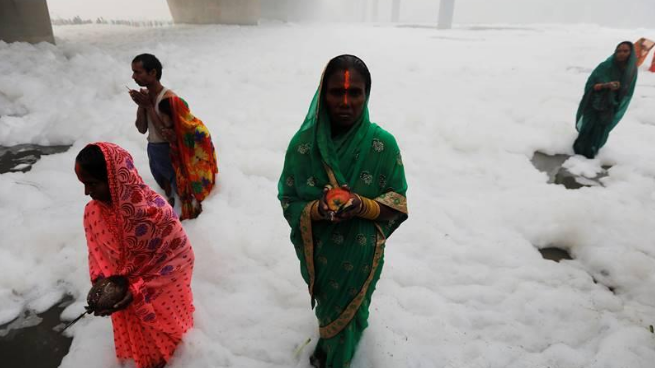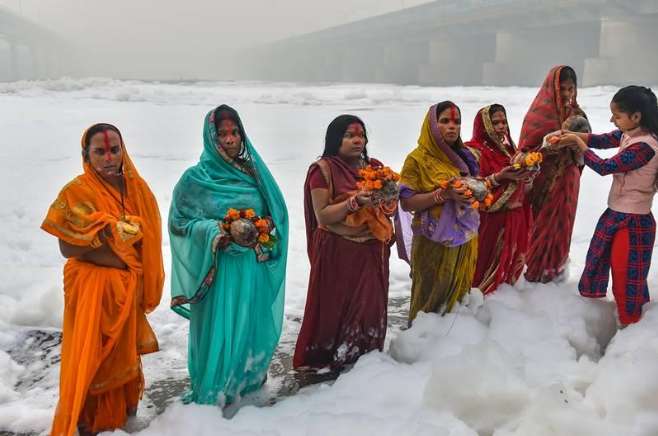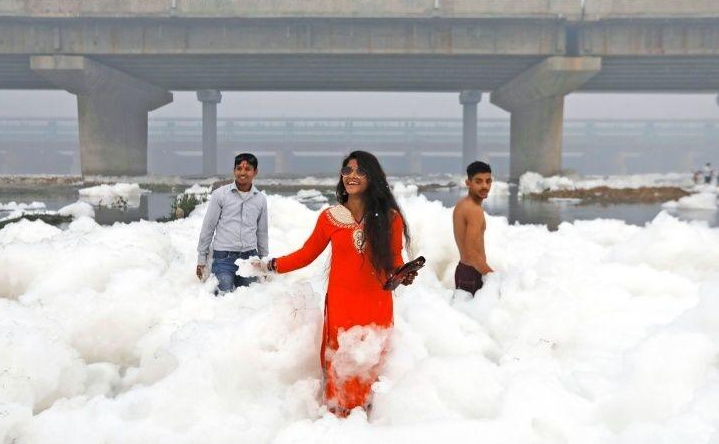
Devotees offer prayers as toxic foam floats on the surface of polluted Yamuna river in New Delhi, November 4, 2019. /Reuters Photo
Devotees offer prayers as toxic foam floats on the surface of polluted Yamuna river in New Delhi, November 4, 2019. /Reuters Photo
"Breathlessness, palpitations, and moist eyes… you're either in love or in New Delhi," is the satirical meme that recently went viral in India as the country's capital imposed a "state of public health emergency" after its air was declared unfit for human consumption. So, as India's politicians fight over who should be blamed, residents are using dark humor to vent their frustration and anger against what many are calling "Airpocalypse."
"When the pain of burning eyes and throat does not go away and you taste the pollution in every breath, when news is filled with stories of toddlers being admitted to hospitals with breathing trouble and our leaders are busy in blame game, there's no place other than social media to voice the anger... humor is the best way to raise awareness" said Delhi resident Khyati Patel while speaking with CGTN Digital, adding "it's a man-made problem and we are all responsible for this toxic mess."

But it's not just air, even the Yamuna river, which passes through Delhi, is spewing toxic white foam. On Monday, images of thousands of women braving the toxic water of the sacred Hindu river left everyone shocked. The devotees stood in knee-deep waters and offered prayers and performed religious rituals in one of the world's most polluted bodies of water as it was covered with "snowy" poisonous foam. Amusingly, some youngsters were also seen playing and posing with the stinky foam.
"People stood in knee-deep foam in Yamuna all because of religious compulsion. This compulsion is not just harrowing... it could also be fateful. Why are we risking everything and for what? My family offers prayers at home. There has to be awareness on a large scale, otherwise these prayers and rituals done for longevity will become the greatest irony of all times," Delhi resident Tanya Singh told CGTN Digital.

Devotees offer prayers as toxic foam floats on the surface of polluted Yamuna river in New Delhi, November 4, 2019. /Reuters Photo
Devotees offer prayers as toxic foam floats on the surface of polluted Yamuna river in New Delhi, November 4, 2019. /Reuters Photo

Youngsters pose for pictures with stinky toxic foam in Yamuna river, New Delhi, November 4, 2019. /Reuters Photo
Youngsters pose for pictures with stinky toxic foam in Yamuna river, New Delhi, November 4, 2019. /Reuters Photo
According to an estimate, more than 19 drains in Delhi flow into the river, and just five percent of the sewage that is discharged into the river is treated, posing a serious health risk since it is also the main source of water for the city. According to recent survey conducted by Daivam Wellness, 41 percent population of India's National Capital Region (NCR) suffers from severe heavy metal toxicity.
Bollywood celebrities ask: 'If Beijing can, why can't we?'
Celebrities like Priyanka Chopra Jonas and Lisa Ray posted pictures on Instagram wearing masks, asking "if Beijing can clean its act, why can't we?"
A news analysis in India's popular India Today magazine said: "The difference between success in China and failure in India is the threshold for rolling out their respective pollution control emergency plan. China works on prediction, hence has a preventive plan. India's model is somewhat like post-mortem – which is rolled out when a certain level has already reached."
A nationwide survey published in Lancet Planetary Health in December 2018 found that at least 1.2 million people died from air pollution-related causes in India, 51.4 percent of these people were younger than 70 years old.